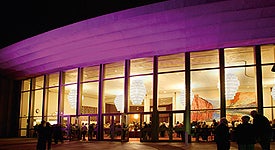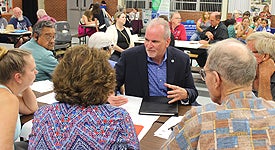The Chandler Municipal Airport tracks aircraft noise concerns to assist in land use planning, help identify concerns, and facilitate communication between pilots and community members. Please be aware that noise concerns do not directly influence aircraft flight paths and, in most cases, do not result in any action against specific pilots or aircraft.
Per federal law, only the Federal Aviation Administration (FAA) has authority over civilian aircraft in flight.
The most efficient way to reach the FAA with your noise concern is to visit Western-Pacific Region Aircraft Noise and Community Involvement Information.
To submit an aircraft noise concern, please use the form below or call the Airport Noise Events HotLine at 480-782-3550. All concerns submitted online or by phone are compiled and reported to the Chandler Airport Commission on a monthly basis. Please note that any information submitted through this website may be subject to a public records request.
Aircraft Identification/Recognition
When submitting aircraft noise complaints to the airport or low-flying aircraft complaints to the FAA, it is important to identify the aircraft accurately with as many of the following items as possible:
- Registration Number - can sometimes be visible on the tail or fuselage. Most of the aircraft will have a registration number beginning with the letter “N”. If you have the registration number, the airplane’s information, including the owner, can be found at the FAA’s database.
For fixed-wing aircraft:
- Aircraft Type: Jet or Propeller engines
- Number of engines: Single engine or multiple engines
- Engine locations: On the wings or body of the plane (fuselage), at the tail or at the front.
- Type of wing:- Straight wing or swept back (if fixed wing)
- Wing mounting: High Wing (on top of the fuselage) or Low Wing (on the bottom of the fuselage)
- Landing Gear:- Retractable Gear (typically only visible during takeoff or landing) or Fixed Gear (visible at all times)
- Color of Aircraft
The Federal Aviation Administration (FAA) is the government agency responsible for aviation safety. It is FAA policy to investigate citizen complaints of low-flying aircraft operated in violation of Federal Aviation Regulations and that might endanger persons or property. Minimum safe altitudes are spelled out in the FAA’s Code of Federal Regulations.
Aircraft can legally fly at altitudes that some residents find annoying or believe to be unsafe. Aside from take-offs and landings, the FAA requires that all aircraft maintain a minimum altitude of 1,000 feet above ground level (AGL) in overpopulated areas and 500 feet AGL over unpopulated areas. There is an exception for helicopters that may operate at lower altitudes.
Only the FAA has regulatory authority over civilian aircraft in flight. Concerns about low-flying aircraft should be directed to the FAA Flight Standards District Office (FSDO), which is responsible for investigating low-flying or unsafe flight incidents with a written complaint.
To report a low-flying aircraft that is not landing at, or taking off from, the Chandler Municipal Airport, please call the local FAA FSDO at 480-284-4450.
Scottsdale FSDO
17777 N. Perimeter Drive, Suite 101
Scottsdale, AZ 85225-5453
Phone: 480-419-0111
Fax: 480-419-0800
Email the Scottsdale FSDO Office
When reporting a low-flying aircraft (including hot air balloons), you may be asked the following questions:
- When did the incident occur?
- Where did it occur?
- What direction was the aircraft flying?
- What was the color?
- Could you tell if the aircraft was military or civilian?
- Did the aircraft have a registration number? (the number will be preceded by the letter “N”)
- How high (low) was the aircraft flying?
- On what do you base your estimate? Was it level with or below the elevation of a prominent object such as a tower or building?
- Are there any witnesses who could confirm your estimate (do you have their names, addresses, phone numbers)?
- Did you take any photographs?
- Are local police aware of the problem? While they have limited authority in aviation matters, police officers are considered “trained observers” by the courts and their written statements or reports make excellent evidence if an enforcement action goes to court.
Aircraft Identification/Recognition
When submitting aircraft noise complaints to the airport or low-flying aircraft complaints to the FAA, it is important to identify the aircraft accurately with as many of the following items as possible:
- Registration Number - can sometimes be visible on the tail or fuselage. Most of the aircraft will have a registration number beginning with the letter “N”. If you have the registration number, the airplane’s information, including the owner, can be found at the FAA’s database.
For fixed-wing aircraft:
- Aircraft Type: Jet or Propeller engines
- Number of engines: Single engine or multiple engines
- Engine locations: On the wings or body of the plane (fuselage), at the tail or at the front.
- Type of wing:- Straight wing or swept back (if fixed wing)
- Wing mounting: High Wing (on top of the fuselage) or Low Wing (on the bottom of the fuselage)
- Landing Gear:- Retractable Gear (typically only visible during takeoff or landing) or Fixed Gear (visible at all times)
- Color of Aircraft
2008 - 2010 FAR 150 Noise Study Initiative
FAR Part 150 is a voluntary program that many U.S. airports perform periodically to determine the noise impact of their current and future planned operations on the surrounding neighborhoods. The study was updated in 2009 and submitted to the FAA for review.
FAA Traffic Pattern Airspace/Flight Paths
FAA Traffic Pattern Airspace is an area around the airport, as defined by the FAA where air traffic overflight can be expected as it approaches and departs the airport. Flight paths vary depending on a variety of factors including origin/destination, wind conditions, aircraft performance characteristics and other aircraft in the traffic pattern. Aircraft may approach and depart the airports from any number of directions. While air traffic may be generalized and depicted by single tracks on a map, it is, by nature, dispersed.



